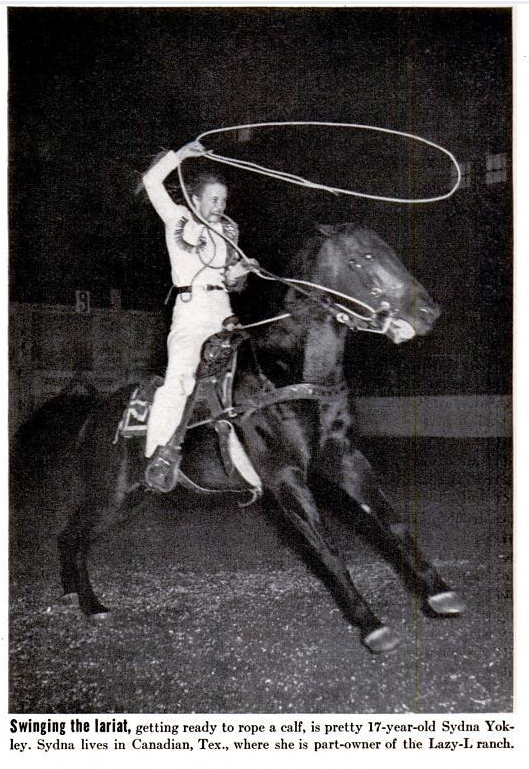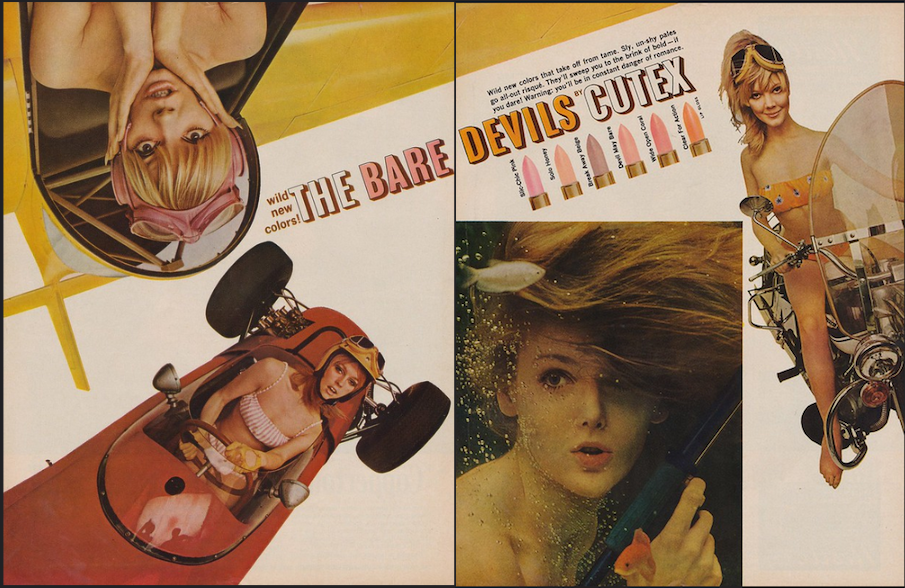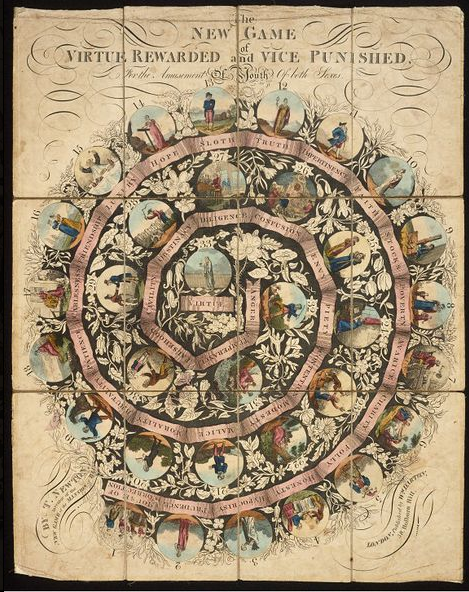Twentieth Century
The Films of Jean Rollin
I confess to never having heard of this director until recently. But his legacy certainly seems one of High Weirdness. A new documentary (first clip) chronicles his career.His Wikipedia page.
Caution: Mild nudity in the clips.
Posted By: Paul - Tue Apr 18, 2023 -
Comments (3)
Category: Horror, Movies, Outsider Art, Fantasy, Europe, Twentieth Century
Sydna Yokley, Rodeo Prodigy
Sydna--seen here in a 1939 LIFE magazine feature--debuted on the rodeo circuit at age 12. She had an outstanding career (see her FIND A GRAVE obit) but died young--under the hooves of her favorite horse.


A nice write-up of her life here.
A 1977 retrospective feature here.

Posted By: Paul - Thu Apr 13, 2023 -
Comments (4)
Category: Animals, Contests, Races and Other Competitions, Regionalism, Sports, North America, Twentieth Century
Señor Wences
Once upon a time, pop culture was very different.The Wikipedia page.
Posted By: Paul - Fri Apr 07, 2023 -
Comments (4)
Category: Puppets and Automatons, Television, Surrealism, Twentieth Century
Smokey Pleacher
His entry at Hillbilly Music Dot Com.
Posted By: Paul - Wed Apr 05, 2023 -
Comments (1)
Category: Hillbillies, Country Bumpkins, Ruralism and Flyover Country, Humor, Ineptness, Crudity, Talentlessness, Kitsch, and Bad Art, Music, Twentieth Century
America’s Most Beautiful Back Contest
I can't be sure if all these videos and photos refer to the same Galveston contest, but it's likely. Except of course for the specifically Florida one.Read about the event--which was briefly revived a decade ago--here.



Posted By: Paul - Thu Mar 30, 2023 -
Comments (2)
Category: Awards, Prizes, Competitions and Contests, Beauty, Ugliness and Other Aesthetic Issues, Regionalism, Twentieth Century
The Mole Man of London
For some reason I recalled recently the odd case of William Lyttle, the Mole Man of London, who dug out a warren of tunnels under his home.Lyttle, originally from Ireland, inherited a 20-room property in the London borough of Hackney. In the mid-sixties he dug out a wine cellar under his home. Having done so, he said that he had "found a taste for the thing" and kept on digging, for some forty years.[2] He created a network of tunnels, wide and narrow, on several levels. Tunnels led in all directions, some of them up to 18 metres (59 ft) in length, and reaching as far down as the water table.[3] One excavation connected with the Dalston Lane tunnel, and the railway line.
I was intrigued to learn that 3 years ago, his derelict house had been renovated and repurposed! Read about it, with many pics, at the link.

Posted By: Paul - Fri Mar 24, 2023 -
Comments (1)
Category: Domestic, Eccentrics, Caves, Caverns, Tunnels and Other Subterranean Venues, United Kingdom, Twentieth Century
Hazel Scott Playing Two Pianos Simultaneously
Her Wikipedia page.See also WU's post on the multi-horn playing of Rahsaan Roland Kirk.
Posted By: Paul - Thu Mar 09, 2023 -
Comments (0)
Category: Human Marvels, Music, Twentieth Century
The Shrine of the Grotto of Redemption
The place's homepage.The Wikipedia entry.

Posted By: Paul - Mon Mar 06, 2023 -
Comments (2)
Category: Buildings and Other Structures, Excess, Overkill, Hyperbole and Too Much Is Not Enough, Religion, Outsider Art, North America, Twentieth Century
Follies of the Madmen #557

Posted By: Paul - Fri Feb 24, 2023 -
Comments (1)
Category: Cosmetics, Daredevils, Stuntpeople and Thrillseekers, Advertising, Twentieth Century
Virtue Board Games
I never knew that "Snakes and Ladders" belonged to this category.Read an excellent short history here.
One example, with description taken from this other site:

A frankly insane 19th century board game.
The game comes on a series of hand painted paper tiles attached to a thin cloth allowing it to be folded up and put into a drawstring case. When unfolded, it forms a spiral-shaped track on the board going from the outside and running anti-clockwise to the centre. Included are some things to use as counters and a spinner, through which a matchstick can be pushed to form a single-dimensional-rotary d4 equivalent. This is intentional by the makers as they did not want to be seen to be encouraging customers to bring a dice box into private homes. Yes, that is the stated reason as given in the rules to this game, which is described as "for the Amusement of Youth of both Sexes."
Also included are a number of tokens which are handed out to players as they play. Players start at the beginning (i.e. before space 1), roll the dice spin the spinner, which yields a value from 1 to 4 (were d4s available in 1818?), and move that number of spaces. Each space is named with either a Virtue or a Vice and every single one has an effect, usually relating to the rewards that such a virtue might bring (i.e. receiving tokens), or the comeuppance of "the dangerous paths of Vice" which do bad things to the player. Apart from "Hope" which requires the player to "wait with patience until the next turn."
So the players spin, move, and things happen to them, much like the Game of the Goose. It's quite clear from reading the rules, however, that the moral behind the game is highly flawed. Many of the Virtue spaces reward you with "tokens" yet these tokens have zero bearing on the outcome of the game. It is mentioned that the first player to land on the final space (with the whole if you overshoot you must count back rule in effect) "claims the contents of the bank and wins the game" yet there is no indication of what the tokens are for. The first player to the final space, imaginatively named "Virtue," wins regardless of how many tokens everyone has. This means that you could have systematically landed on every vice space imaginable but if you're first to land on the final space exactly, you win regardless of the number of tokens in the bank. The rules also don't specify how many tokens should go in the bank and with the preponderance of "vice" spaces that send you back often a long way, i.e. to "House of Correction" (space 1) or "Stocks" (space 9) a player skilled in fudging spinner spins could well find themselves with an infinite number of tokens. So even if you insert the house rule that the player with the most tokens wins, the player getting to the end "claims the contents of the bank" and therefore has infinity tokens and wins that way.
So what's the real moral message imparted by this game? That stopping to help and be charitable and nice is all well and good but the victory in life goes to whoever barges through the fastest or to the luckiest player. The attempt at inculcating a set of moral values into the youth of both sexes is undermined by the fact that players don't have to make any active choice; at the end of the day, whoever spins the lucky numbers gets the prize at the end of the day.
I can't help but feel that this kid of explains something about Victorian morality though I can't think what.
Posted By: Paul - Fri Feb 10, 2023 -
Comments (0)
Category: Games, Nineteenth Century, Twentieth Century, Ethics and Morals

| Who We Are |
|---|
| Alex Boese Alex is the creator and curator of the Museum of Hoaxes. He's also the author of various weird, non-fiction, science-themed books such as Elephants on Acid and Psychedelic Apes. Paul Di Filippo Paul has been paid to put weird ideas into fictional form for over thirty years, in his career as a noted science fiction writer. He has recently begun blogging on many curious topics with three fellow writers at The Inferior 4+1. Contact Us |




